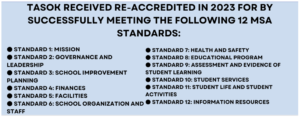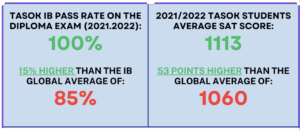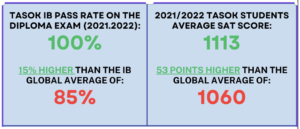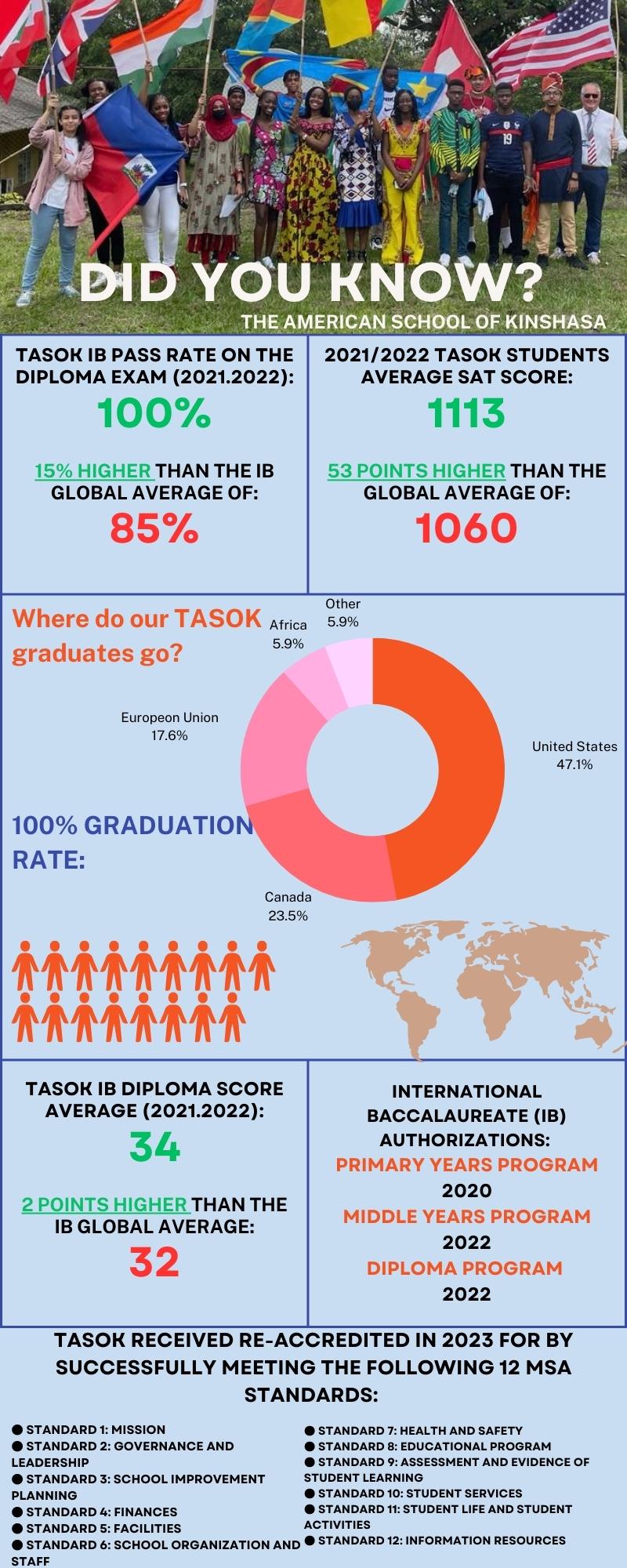TASOK is monitored and accredited by two international organizations that evaluate our teaching practices, programs, policies, and standards, to ensure they meet high U.S. and international standards. These are continually reviewed and evaluated to allow TASOK to fulfill our Mission of academic excellence.
These are:

YES: The purpose of The American School of Kinshasa (TASOK) Safety Plan is to establish guidelines and policies for staff to follow in preparing for, or in the event of an emergency. This handbook also outlines protocols for general safety and security at TASOK. The primary objective of this plan is to provide for the safety, protection, and welfare of the students, staff, and property of The American School of Kinshasa.
The ultimate objective of the plan is to form a partnership between The American School of Kinshasa, the US Embassy, local government and our contracted security, in order to be proactive and ready for any situation that we face.
The American School of Kinshasa Safety Plan is a work that is constantly evolving and developing with the needs of the school. The Safety Plan Committee who approved and updated this plan is made up of members of TASOK, and shared with the U.S. Embassy RSO for input. Consequently, this plan would not be possible, or effective, if not for the contribution of all of those involved in its creation.
In addition to a detailed safety plan, an Incident Command Structure has been developed and included in this document to ensure proper communication during a crisis, and delineate duties to administration and other staff as assigned.
Please refer to the Table of Contents for the specific area of safety procedures, disaster routines, policies and related information.
For the complete plan click: https://docs.google.com/document/d/1pezXEV5Gbg6dSPSyhJZzTcgm0TInQHrcvMCRUGXdA6c/edit?usp=sharing
To view the complete TASOK Child Protection Policy click: https://tasok.net/wp-content/uploads/2022/08/TASOK-Child-Protection-Policy-and-Procedures-2022-2023.pdf
Child abuse and neglect are concerns throughout the world. Child abuse and neglect are violations of a child’s human rights and are obstacles to the child’s education as well as to their physical, emotional, and spiritual development. The American School of Kinshasa endorses the UN Convention on the Rights of the Child, of which our host country, The Democratic Republic of Congo, is a signatory. Schools fill a special institutional role in society as protectors of children. Schools need to ensure that all children in their care are afforded a safe and secure environment in which to grow and develop, both at school and away. Educators, having the opportunity to observe and interact with children over time, are in a unique position to identify children who are in need of help and protection. As such,educators have a professional and ethical obligation to identify children who are in need of help and protection. As such, educators have a professional and ethical obligation to identify children who are in need of help and protection and to take steps to ensure that the child and family avail themselves of the services needed to remedy any situation that constitutes child abuse or neglect.
All staff employed at The American School of Kinshasa must report incidents of child abuse or neglect whenever the staff member has reasonable cause to believe that a child has suffered or is at significant risk of suffering abuse or neglect. Reporting and follow up of all suspected incidents of child abuse or neglect may be reported to the appropriate employer, to the respective consulate in Kinshasa, to the appropriate child protection agency in the home country, and/or to local authorities. The American School of Kinshasa seeks to be a safe haven for students who may be experiencing abuse or neglect in any aspect of their lives. As such, The American School of Kinshasa will distribute this policy annually to all parents and applicants, will communicate this policy to students, will provide training for all staff, and will make every effort to implement hiring practices to ensure the safety of children. In the case of a staff member reported as an alleged offender, The American School of Kinshasa will conduct a full investigation following a carefully designed course of due process, keeping the safety of the child at the highest priority.
For detailed information on the Convention on the Rights of the Child see the following link: http://www.unicef.org/crc/index_30160.html
Purpose Flansburgh Architects was retained to visit TASOK and conduct a facility audit of its existing campus. The purpose of this audit was to evaluate whether the existing facilities are meeting the immediate needs of TASOK and identify what changes would be required to accommodate a growth rate of approximately 20 students per year over the next 20 years. It was understood that any recommendations would be made in the context of the challenging social, economic and technical conditions that exist in the Democratic Republic of the Congo.
Process Flansburgh Architects spent one intense week at TASOK to understand the culture of the campus and investigate the condition of its existing facilities. During the visit we met with administration, faculty, board members, parents, maintenance staff and every high school student through group meetings, classroom visits, one-on-one interviews and informal dinners. We gathered all available documentation showing the layout of the existing campus and with the assistance of Brian Trapp were able to locate and describe otherwise undocumented structures.
Goals TASOK identified four major goals:
Recommendations
*Renovate one typical middle school classroom building to become a new prototypical, climate responsive and self-sustaining classroom for the 21st century. This remade classroom building would be connected to an outdoor forest classroom dedicated to the study, care and preservation of the rainforest. As a prototype it would serve as an example of what could be achieved if every classroom building were renovated and would be an unmistakable guide for future improvements.
* Establish forest preservation zones where future development is prohibited and respect for the indigenous rain forest is encouraged.
YES:
5.4 ADMISSIONS POLICY
5.4.1 The total enrollment of the School and class size limits are approved by a majority vote of the Board.
5.4.2 The School does not discriminate on the basis of race, sex, religion,political or other opinion, in its admission practices.
5.4.3 The School admits, according to available resources, students whose learning needs can be effectively supported by current resources of the School.
5.4.4 The School reserves the right to retain or advance a student grade level on the recommendation of faculty and with written approval of the Director.
5.4.5 The admissions process, including screening and testing, will be the responsibility through oversight of the Director. The admissions process will be published and made known to the Board and to the public.( https://tasok.net/apply-to-tasok/ )
5.4.6 The School gives admissions priority to students based on prioritization as follows:
2.2.1 Method of Election of Board Members
2.2.101 For elections of candidates for the Board, the Board must issue a list of candidates at least twenty-one (21) days prior to the scheduled election and can publish to the Association membership the candidates’ individual submissions regarding qualifications for, and interest in a Board seat.
2.2.102 A candidate must indicate a willingness to serve before being placed on a ballot or elected to the Board. If there are not sufficient candidates for vacant seats on the Board, additional nominations may be made from the floor.
2.2.103 All votes must follow the procedures as outlined in the written notice distributed to Association Members at least two (2) weeks prior to the scheduled Association General Meeting.
2.2.104 Votes may be cast in person or electronically as outlined in the written notice distributed to Association Members at least two (2) weeks prior to the scheduled Association General Meeting. Votes will be tallied at the meeting by persons selected by sitting Board members. The candidates receiving the largest number of votes will be deemed elected to the Board.
2.2.105 In the case of a tie in a Board election, a runoff shall be held immediately between the candidates who obtained the same number of votes in order to decide the winner(s) of the contested Board seat(s).
2.2.106 During the course of an election for Board members and/or the Association members’ voting on a resolution, the Board Secretary shall record which members have lodged votes on a registrar of general members in good standing.
2.1.203 The Board does not involve itself in the actual operation of the school, which is the purview of the Director. The specific duties of the Board are as follows:
The Association General Meeting (AGM) is held twice per year to share information and updates with Association Members. These typically take place in October and May, sharing the Board Goals, Strategic Planning, program updates, elections,and sharing of the financial report by the Board Treasurer.
Section 2 – REGULAR MEETINGS
A general meeting of the Association shall be called during the first quarter of the school year by the ranking incumbent officer. In addition to other Association business, an election shall be held for any Board positions unfilled at the prior year’s last-quarter meeting.
A second general meeting of the Association shall be held within the last quarter of the school year. In addition to other Association business, the election of officers shall be held at this meeting.
Each year the Board sends out a ‘Stakeholder Survey’ to solicit feedback from the community. As part of this survey, questions ask the Association for input on the changing needs of our community. This feedback is then discussed with the Board Standing Committees (Strategic, Finance, and Trustee) and compared against the Master Plan. Once approved, the proposed improvements are shared at the annual AGM and throughout the year via the TASOK Talk.
2.6 BOARD COMMITTEES
2.6.1 The Board will ensure sufficient participation and functioning of three standing committees:
Finance Committee
Purpose: The Committee exercises general oversight over school finances, recommends draft annual budgets for Board approval, and develops and refines the rolling, five-year financial plan that enables the achievement of the five-year rolling strategic plan.
Strategic Planning Committee
Purpose: The Committee develops and maintains a rolling five-year strategic plan in connection with the five-year financial plan to achieve TASOK’s mission and long-term objectives and provide sufficient input to the Finance Committee to inform the five-year financial plan that will enable the achievement of the five-year rolling strategic plan.
Trustee Committee
Purpose: Ensures board continuity by cultivating and developing a strong pool of candidates that can stand for selection each year and that good governance practices are followed by the Board.
2.7 BOARD GOALS AND EVALUATION
2.7.1 Board Goals
2.7.101 At the beginning of the school year the Board shall set its short-term goals and objectives for the academic year and review the strategic plan.
2.7.102 These goals and status of the Strategic Management Plan shall be reported at the Association General Meeting in the first semester.
2.7.103 At the AGM in the second semester, the President shall report on progress made by the Board in achieving its short-term goals and objectives, and the longer term goals and objectives outlined in the rolling five-year Strategic and Financial Plans.
2.7.2 Board Self-Evaluation
2.7.201 The Board shall conduct an annual self-evaluation before the end of the school year, using an evaluation tool that has been recommended by the Trustee Committee and decided upon during the first semester.
Yes! TASOK is the only SAT test center in the Democratic Republic of Congo. Students come from all over the world to take the SAT for university applications.


Yes, TASOK offers financial aid opportunities for existing families twice per year. The applications are in both English and French and can be found on our Business Office website page: https://tasok.net/business-operations/
The Financial Aid windows are: May/June for Semester 1 and Nov/Dec for Semester 2.

